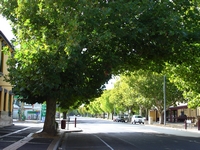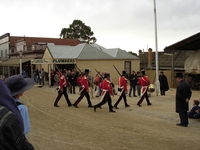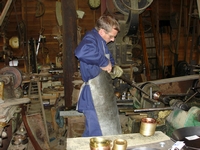Australia So Much to See




After a ‘rock and roll crossing’ from
Leaving
Looking for a quiet spot to enjoy the bush
for the night, we drove into the
The
park’s longer walks were closed due to bushfire damage, but the northern section where we were remained unscathed. We spent
a peaceful night in the woodlands which are rich with bird life.
At Ballarat we spent the day visiting Sovereign Hill, the re-created historical mining town and museum. This busy tourist feature
is very well presented and worth visiting and really needs more than day to see the museum and the re-created town thoroughly. You can get your ticket extended for a further day’s visit any time within a twelve month period.
Trades such as the
tin smith and brass foundry demonstrate methods from the period, and products made can be purchased as souvenirs at very reasonable
prices.
Original steam engines drive the pumps which operate the demonstration underground mine. Down in the
mine, the story of finding the Welcome Nugget is told with holographic figures. At 64 kilograms, it is the second largest gold
nugget ever found in the world.
Leaving Ballarat, we continued west past wheat, sheep and cattle farms to the
Following a loop road we passed a wind farm of forty
turbines, before reaching Ararat.
I was keen to visit the Grampians, however severe fires during January and February had burnt
almost the entire park. Thirty kilometres east of the park, the farmlands were also all burnt. Most of the roads and trails
were still closed whilst clearing fallen and unsafe trees and branches continued. Only the northern section of the park had
been opened.
At the Boroka lookout, a huge vista of more than 180º gave views across farmlands to the north and
east, and south, across the Hall’s Gap settlement to one of the dams in the park. In the valley, Hall’s Gap had been spared. Rugged black volcanic rocks.
While green shoots came from the trunks of the surviving trees, park workers had created new seats
along the walk trails from the fallen timber they had cleared.
At The Balconies, an overhanging rock is like a giant dragon’s
head. This lookout also gave expansive views.
Overlooking the burnt valley to
We camped at the
Next we headed north through the dry Wimmera wheat growing region toJeparit; birth place of former long serving Prime Minister, Sir Robert Menzies. Near here,
We visited a farm nearby. It was very windy and rain clouds threatened as farmers waited and wished for the opening rains to start seeding.
A Nhill, the wind was cold as it brought light showers. Next morning the weather was fine so we took a walk across the board walk through a now dry wetlands and bird watching park to a small dam.
Update: In November 2008 a public meeting in Nhill Aero Clubrooms unanimously endorsed a motion:
`That this meeting recognizes the importance
of Nhill Aerodrome
in the on-going history of Nhill and supports
the creation of an
aviation memorial with focus initially
on the RAAF presence at
Nhill from 1941-46’.
With many
hours of work on the hangar and restoration of planes by community members, the official opening of the new hangar will be held on
the 23rd of May 2014


